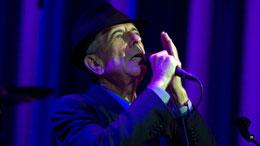Leonard Cohen had a quiet, decades-long devotion to Indian philosophy and the city of Bombay

Photo caption: Bird on a wire. (AP Photo/MTI, Peter Kollanyi)
By Ratnesh Mathur, (Quartz)
In 1998, I read a newspaper report that Leonard Cohen was in Bombay. I was a big fan of his music and poetry and I tracked him down to a small hotel in Kemp’s Corner. I asked if he could autograph the CDs and books I intended to leave at the reception, but Cohen came out and invited me to stay for a chat, instead. It turned out to be a five-hour discussion—the start of a friendship for the next 18 years. We exchanged our last emails just five weeks ago, on his 82nd birthday.
Every day in that autumn of 1998, Cohen was reciting the verses of the 13th-century Marathi bhakti poet Sant Dnyaneshwar. He was in Bombay to attend the satsangs of Advaita guru Ramesh Balsekar at Warden Road. He wasn’t just reciting the verses by rote; he knew the English meanings of the words. He was pondering the concepts of sagun (the worship of God with form) and nirgun (the worship of God without form) and why both were essentially the same.
When he arrived in India in 1998, Leonard Cohen was already a Zen monk. He had spent five years in deep meditation and silence with Zen guru Roshi in Mount Baldy, near Los Angeles. It had been a decade since he had recorded new music or performed. The guru of 1960s folk and poetry had entirely stepped out of public life. Instead, his life-long quest for knowledge and inner peace had completely consumed his time and attention. He was led to Bombay by his curiosity to meet Balsekar, the author of a book titled Consciousness Speaks he read in his monastery.
Cohen spent much of 1999 and 2000 in Bombay, and then made brief visits until 2003. It was always for one purpose—to attend Balsekar’s daily morning satsangs and spend time with the teacher. Many of these conversations during the satsang have been preserved in audio and video recordings by Balsekar’s devotees. Between the Buddhist teachings of Roshi and the Vedanta teachings of Balsekar, Cohen finally found the inner peace that he had been seeking all his adult life. Sylvie Simmons’s excellent biography, I’m Your Man, explains this very well. During this period, Cohen got back to writing poetry and sketching in his art book.
Some Sunday mornings, Cohen took us along to Balsekar’s satsangs. These were Vedanta question-and-answer style discussions at which Balsekar’s philosophy appeared to have answers to every big question in life. The teacher’s clarity of thought and his delivery in English had attracted many Western seekers. During most sessions, Cohen sat quiet but attentive. As the friendship between Cohen and Balsekar developed, they would spend time alone in the evenings too, away from the satsang devotees.
This piece was originally appeared in Quartz (qz.com). To read the rest of the piece go to: http://qz.com/836349/leonard-cohen-had-a-devotion-to-indian-philosophy-and-the-city-of-bombay/









